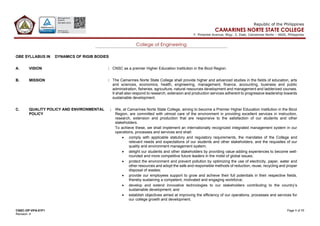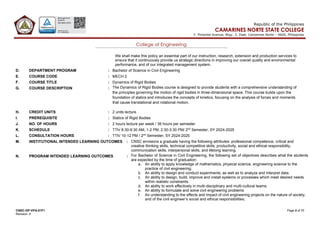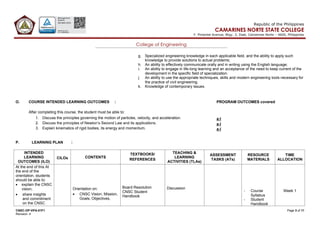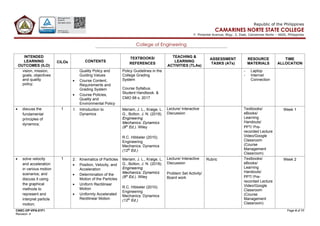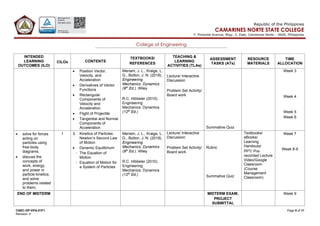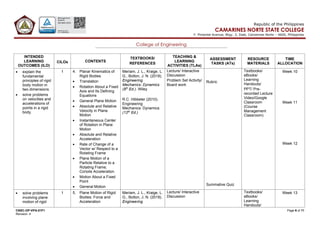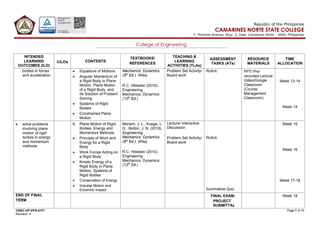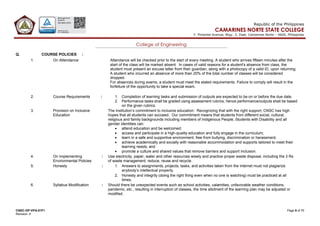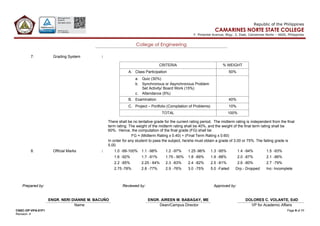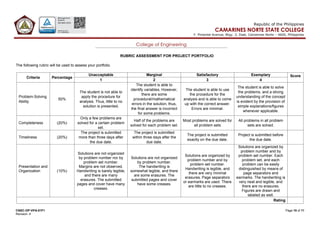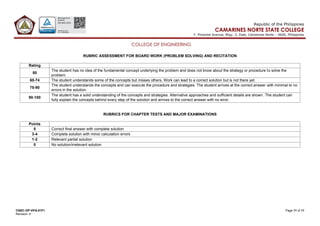MECH-2-Syllabus.pfgdfggfgggfgfgfggfgfgfdf
- 1. CNSC-OP-VPA-01F1 Page 1 of 11 Revision: 4 Republic of the Philippines CAMARINES NORTE STATE COLLEGE F. Pimentel Avenue, Brgy. 2, Daet, Camarines Norte ŌĆō 4600, Philippines College of Engineering OBE SYLLABUS IN DYNAMICS OF RIGIB BODIES A. VISION : CNSC as a premier Higher Education Institution in the Bicol Region. B. MISSION : The Camarines Norte State College shall provide higher and advanced studies in the fields of education, arts and sciences, economics, health, engineering, management, finance, accounting, business and public administration, fisheries, agriculture, natural resources development and management and ladderized courses. It shall also respond to research, extension and production services adherent to progressive leadership towards sustainable development. C. QUALITY POLICY AND ENVIRONMENTAL POLICY : We, at Camarines Norte State College, aiming to become a Premier Higher Education Institution in the Bicol Region, are committed with utmost care of the environment in providing excellent services in instruction, research, extension and production that are responsive to the satisfaction of our students and other stakeholders. To achieve these, we shall implement an internationally recognized integrated management system in our operations, processes and services and shall: ŌĆó comply with applicable statutory and regulatory requirements, the mandates of the College and relevant needs and expectations of our students and other stakeholders, and the requisites of our quality and environment management system; ŌĆó delight our students and other stakeholders by providing value-adding experiences to become well- rounded and more competitive future leaders in the midst of global issues; ŌĆó protect the environment and prevent pollution by optimizing the use of electricity, paper, water and other resources and adopt the safe and responsible methods of reduction, reuse, recycling and proper disposal of wastes; ŌĆó provide our employees support to grow and achieve their full potentials in their respective fields, thereby sustaining a competent, motivated and engaging workforce; ŌĆó develop and extend innovative technologies to our stakeholders contributing to the countryŌĆÖs sustainable development; and ŌĆó establish objectives aimed at improving the efficiency of our operations, processes and services for our college growth and development.
- 2. CNSC-OP-VPA-01F1 Page 2 of 11 Revision: 4 Republic of the Philippines CAMARINES NORTE STATE COLLEGE F. Pimentel Avenue, Brgy. 2, Daet, Camarines Norte ŌĆō 4600, Philippines College of Engineering We shall make this policy an essential part of our instruction, research, extension and production services to ensure that it continuously provide us strategic directions in improving our overall quality and environmental performance, and of our integrated management system. D. DEPARTMENT PROGRAM : Bachelor of Science in Civil Engineering E. COURSE CODE : MECH 2 F. COURSE TITLE : Dynamics of Rigid Bodies G. COURSE DESCRIPTION : The Dynamics of Rigid Bodies course is designed to provide students with a comprehensive understanding of the principles governing the motion of rigid bodies in three-dimensional space. This course builds upon the foundation of statics and introduces the concepts of kinetics, focusing on the analysis of forces and moments that cause translational and rotational motion. H. CREDIT UNITS : 2 units lecture I. PREREQUISITE : Statics of Rigid Bodies J. NO. OF HOURS : 2 hours lecture per week / 36 hours per semester K. SCHEDULE : TTh/ 8:30-9:30 AM, 1-2 PM, 2:30-3:30 PM/ 2nd Semester, SY 2024-2025 L. CONSULTATION HOURS : TTh/ 10-12 PM / 2nd Semester, SY 2024-2025 M. INSTITUTIONAL INTENDED LEARNING OUTCOMES : CNSC envisions a graduate having the following attributes: professional competence, critical and creative thinking skills, technical competitive skills, productivity, social and ethical responsibility, communication skills, interpersonal skills, and lifelong learning. N. PROGRAM INTENDED LEARNING OUTCOMES : For Bachelor of Science in Civil Engineering, the following set of objectives describes what the students are expected by the time of graduation: a. An ability to apply knowledge of mathematics, physical science, engineering science to the practice of civil engineering; b. An ability to design and conduct experiments, as well as to analyze and interpret data; c. An ability to design, build, improve and install systems or processes which meet desired needs within realistic constraints. d. An ability to work effectively in multi-disciplinary and multi-cultural teams; e. An ability to formulate and solve civil engineering problems f. An understanding to the effects and impact of civil engineering projects on the nature of society, and of the civil engineerŌĆÖs social and ethical responsibilities;
- 3. CNSC-OP-VPA-01F1 Page 3 of 11 Revision: 4 Republic of the Philippines CAMARINES NORTE STATE COLLEGE F. Pimentel Avenue, Brgy. 2, Daet, Camarines Norte ŌĆō 4600, Philippines College of Engineering g. Specialized engineering knowledge in each applicable field, and the ability to apply such knowledge to provide solutions to actual problems; h. An ability to effectively communicate orally and in writing using the English language; i. An ability to engage in life-long learning and an acceptance of the need to keep current of the development in the specific field of specialization. j. An ability to use the appropriate techniques, skills and modern engineering tools necessary for the practice of civil engineering. k. Knowledge of contemporary issues. O. COURSE INTENDED LEARNING OUTCOMES : After completing this course, the student must be able to: 1. Discuss the principles governing the motion of particles, velocity, and acceleration. 2. Discuss the principles of NewtonŌĆÖs Second Law and its applications. 3. Explain kinematics of rigid bodies, its energy and momentum. PROGRAM OUTCOMES covered a-l a-l a-l P. LEARNING PLAN : INTENDED LEARNING OUTCOMES (ILO) CILOs CONTENTS TEXTBOOKS/ REFERENCES TEACHING & LEARNING ACTIVITIES (TLAs) ASSESSMENT TASKS (ATs) RESOURCE MATERIALS TIME ALLOCATION At the end of this At the end of the orientation, students should be able to: ŌĆó explain the CNSC vision; ŌĆó share insights and commitment on the CNSC Orientation on: ŌĆó CNSC Vision, Mission, Goals, Objectives, Board Resolution CNSC Student Handbook Discussion - Course Syllabus - Student Handbook Week 1
- 4. CNSC-OP-VPA-01F1 Page 4 of 11 Revision: 4 Republic of the Philippines CAMARINES NORTE STATE COLLEGE F. Pimentel Avenue, Brgy. 2, Daet, Camarines Norte ŌĆō 4600, Philippines College of Engineering INTENDED LEARNING OUTCOMES (ILO) CILOs CONTENTS TEXTBOOKS/ REFERENCES TEACHING & LEARNING ACTIVITIES (TLAs) ASSESSMENT TASKS (ATs) RESOURCE MATERIALS TIME ALLOCATION vision, mission, goals, objectives and quality policy; Quality Policy and Guiding Values ŌĆó Course Content, Requirements and Grading System ŌĆó Course Policies, Quality and Environmental Policy Policy Guidelines in the College Grading System Course Syllabus. Student Handbook. & CMO 88 s. 2017 - Laptop - Internet Connection ŌĆó discuss the fundamental principles of dynamics; 1 1. Introduction to Dynamics Meriam, J. L., Kraige, L. G., Bolton, J. N. (2018). Engineering Mechanics: Dynamics (9th Ed.). Wiley R.C. Hibbeler (2010). Engineering Mechanics: Dynamics (12th Ed.) Lecture/ Interactive Discussion Textbooks/ eBooks/ Learning Handouts/ PPT/ Pre- recorded Lecture Video/Google Classroom (Course Management Classroom) Week 1 ŌĆó solve velocity and acceleration in various motion scenarios; and discuss it using the graphical methods to represent and interpret particle motion; 1 2. Kinematics of Particles ŌĆó Position, Velocity, and Acceleration ŌĆó Determination of the Motion of the Particles ŌĆó Uniform Rectilinear Motion ŌĆó Uniformly Accelerated Rectilinear Motion Meriam, J. L., Kraige, L. G., Bolton, J. N. (2018). Engineering Mechanics: Dynamics (9th Ed.). Wiley R.C. Hibbeler (2010). Engineering Mechanics: Dynamics (12th Ed.) Lecture/ Interactive Discussion Problem Set Activity/ Board work Rubric Textbooks/ eBooks/ Learning Handouts/ PPT/ Pre- recorded Lecture Video/Google Classroom (Course Management Classroom) Week 2
- 5. CNSC-OP-VPA-01F1 Page 5 of 11 Revision: 4 Republic of the Philippines CAMARINES NORTE STATE COLLEGE F. Pimentel Avenue, Brgy. 2, Daet, Camarines Norte ŌĆō 4600, Philippines College of Engineering INTENDED LEARNING OUTCOMES (ILO) CILOs CONTENTS TEXTBOOKS/ REFERENCES TEACHING & LEARNING ACTIVITIES (TLAs) ASSESSMENT TASKS (ATs) RESOURCE MATERIALS TIME ALLOCATION ŌĆó Position Vector, Velocity, and Acceleration ŌĆó Derivatives of Vector Functions ŌĆó Rectangular Components of Velocity and Acceleration ŌĆó Flight of Projectile ŌĆó Tangential and Normal Components of Acceleration Meriam, J. L., Kraige, L. G., Bolton, J. N. (2018). Engineering Mechanics: Dynamics (9th Ed.). Wiley R.C. Hibbeler (2010). Engineering Mechanics: Dynamics (12th Ed.) Lecture/ Interactive Discussion Problem Set Activity/ Board work Summative Quiz Week 3 Week 4 Week 5 Week 6 ŌĆó solve for forces acting on particles using free-body diagrams; ŌĆó discuss the concepts of work, energy, and power in particle kinetics; and solve problems related to them; 1 3. Kinetics of Particles: NewtonŌĆÖs Second Law of Motion ŌĆó Dynamic Equilibrium - The Equation of Motion - Equation of Motion for a System of Particles Meriam, J. L., Kraige, L. G., Bolton, J. N. (2018). Engineering Mechanics: Dynamics (9th Ed.). Wiley R.C. Hibbeler (2010). Engineering Mechanics: Dynamics (12th Ed.) Lecture/ Interactive Discussion Problem Set Activity/ Board work Rubric Summative Quiz Textbooks/ eBooks/ Learning Handouts/ PPT/ Pre- recorded Lecture Video/Google Classroom (Course Management Classroom) Week 7 Week 8-9 END OF MIDTERM MIDTERM EXAM; PROJECT SUBMITTAL Week 9
- 6. CNSC-OP-VPA-01F1 Page 6 of 11 Revision: 4 Republic of the Philippines CAMARINES NORTE STATE COLLEGE F. Pimentel Avenue, Brgy. 2, Daet, Camarines Norte ŌĆō 4600, Philippines College of Engineering INTENDED LEARNING OUTCOMES (ILO) CILOs CONTENTS TEXTBOOKS/ REFERENCES TEACHING & LEARNING ACTIVITIES (TLAs) ASSESSMENT TASKS (ATs) RESOURCE MATERIALS TIME ALLOCATION ŌĆó explain the fundamental principles of rigid body motion in two dimensions. ŌĆó solve problems on velocities and accelerations of points in a rigid body. 1 4. Planar Kinematics of Rigid Bodies ŌĆó Translation ŌĆó Rotation About a Fixed Axis and Its Defining Equations ŌĆó General Plane Motion ŌĆó Absolute and Relative Velocity in Plane Motion ŌĆó Instantaneous Center of Rotation in Plane Motion ŌĆó Absolute and Relative Acceleration ŌĆó Rate of Change of a Vector w/ Respect to a Rotating Frame ŌĆó Plane Motion of a Particle Relative to a Rotating Frame; Coriolis Acceleration ŌĆó Motion About a Fixed Point ŌĆó General Motion Meriam, J. L., Kraige, L. G., Bolton, J. N. (2018). Engineering Mechanics: Dynamics (9th Ed.). Wiley R.C. Hibbeler (2010). Engineering Mechanics: Dynamics (12th Ed.) Lecture/ Interactive Discussion Problem Set Activity/ Board work Rubric Summative Quiz Textbooks/ eBooks/ Learning Handouts/ PPT/ Pre- recorded Lecture Video/Google Classroom (Course Management Classroom) Week 10 Week 11 Week 12 ŌĆó solve problems involving plane motion of rigid 1 5. Plane Motion of Rigid Bodies: Force and Acceleration Meriam, J. L., Kraige, L. G., Bolton, J. N. (2018). Engineering Lecture/ Interactive Discussion Textbooks/ eBooks/ Learning Handouts/ Week 13
- 7. CNSC-OP-VPA-01F1 Page 7 of 11 Revision: 4 Republic of the Philippines CAMARINES NORTE STATE COLLEGE F. Pimentel Avenue, Brgy. 2, Daet, Camarines Norte ŌĆō 4600, Philippines College of Engineering INTENDED LEARNING OUTCOMES (ILO) CILOs CONTENTS TEXTBOOKS/ REFERENCES TEACHING & LEARNING ACTIVITIES (TLAs) ASSESSMENT TASKS (ATs) RESOURCE MATERIALS TIME ALLOCATION bodies in forces and acceleration ŌĆó Equations of Motions ŌĆó Angular Momentum of a Rigid Body in Plane Motion; Plane Motion of a Rigid Body, and Its Solution of Problem Solving ŌĆó Systems of Rigid Bodies ŌĆó Constrained Plane Motion Mechanics: Dynamics (9th Ed.). Wiley R.C. Hibbeler (2010). Engineering Mechanics: Dynamics (12th Ed.) Problem Set Activity/ Board work Rubric PPT/ Pre- recorded Lecture Video/Google Classroom (Course Management Classroom) Week 13-14 Week 14 ŌĆó solve problems involving plane motion of rigid bodies in energy and momentum methods 6. Plane Motion of Rigid Bodies: Energy and Momentum Methods ŌĆó Principle of Work and Energy for a Rigid Body ŌĆó Work Forces Acting on a Rigid Body ŌĆó Kinetic Energy of a Rigid Body in Plane Motion; Systems of Rigid Bodies ŌĆó Conservation of Energy ŌĆó Impulse Motion and Eccentric Impact Meriam, J. L., Kraige, L. G., Bolton, J. N. (2018). Engineering Mechanics: Dynamics (9th Ed.). Wiley R.C. Hibbeler (2010). Engineering Mechanics: Dynamics (12th Ed.) Lecture/ Interactive Discussion Problem Set Activity/ Board work Rubric Summative Quiz Week 15 Week 16 Week 17-18 END OF FINAL TERM FINAL EXAM; PROJECT SUBMITTAL Week 18
- 8. CNSC-OP-VPA-01F1 Page 8 of 11 Revision: 4 Republic of the Philippines CAMARINES NORTE STATE COLLEGE F. Pimentel Avenue, Brgy. 2, Daet, Camarines Norte ŌĆō 4600, Philippines College of Engineering Q. COURSE POLICIES : 1. On Attendance Attendance will be checked prior to the start of every meeting. A student who arrives fifteen minutes after the start of the class will be marked absent. In cases of valid reasons for a student's absence from class, the student must present an excuse letter from their guardian, along with a photocopy of a valid ID, upon returning. A student who incurred an absence of more than 20% of the total number of classes will be considered dropped. For absences during exams, a student must meet the stated requirements. Failure to comply will result in the forfeiture of the opportunity to take a special exam. 2. Course Requirements : 1. Completion of learning tasks and submission of outputs are expected to be on or before the due date. 2. Performance tasks shall be graded using assessment rubrics; hence performance/outputs shall be based on the given rubrics. 3. Provision on Inclusive Education The institutionŌĆÖs commitment to inclusive education: Recognizing that with the right support, CNSC has high hopes that all students can succeed. Our commitment means that students from different social, cultural, religious and family backgrounds including members of Indigenous People, Students with Disability and all gender identities can: ŌĆó attend education and be welcomed; ŌĆó access and participate in a high-quality education and fully engage in the curriculum; ŌĆó learn in a safe and supportive environment, free from bullying, discrimination or harassment; ŌĆó achieve academically and socially with reasonable accommodation and supports tailored to meet their learning needs; and ŌĆó promote a culture and shared values that remove barriers and support inclusion. 4. On Implementing Environmental Policies : Use electricity, paper, water and other resources wisely and practice proper waste disposal, including the 3 Rs of waste management; reduce, reuse and recycle. 5. Honesty : 1. Answers to assignments, projects, tasks, and activities taken from the internet must not plagiarize anybodyŌĆÖs intellectual property. 2. Honesty and integrity (doing the right thing even when no one is watching) must be practiced at all times. 6. Syllabus Modification : Should there be unexpected events such as school activities, calamities, unfavorable weather conditions, pandemic, etc., resulting in interruption of classes, the time allotment of the learning plan may be adjusted or modified.
- 9. CNSC-OP-VPA-01F1 Page 9 of 11 Revision: 4 Republic of the Philippines CAMARINES NORTE STATE COLLEGE F. Pimentel Avenue, Brgy. 2, Daet, Camarines Norte ŌĆō 4600, Philippines College of Engineering 7. Grading System : CRITERIA % WEIGHT A. Class Participation 50% a. Quiz (30%) b. Synchronous or Asynchronous Problem Set Activity/ Board Work (15%) c. Attendance (5%) B. Examination 40% C. Project ŌĆō Portfolio (Compilation of Problems) 10% TOTAL 100% There shall be no tentative grade for the current rating period. The midterm rating is independent from the final term rating. The weight of the midterm rating shall be 40%, and the weight of the final term rating shall be 60%. Hence, the computation of the final grade (FG) shall be: FG = (Midterm Rating x 0.40) + (Final Term Rating x 0.60) In order for any student to pass the subject, he/she must obtain a grade of 3.00 or 75%. The failing grade is 5.00. 8. Official Marks : 1.0 -99-100% 1.1 -98% 1.2 -97% 1.25 -96% 1.3 -95% 1.4 -94% 1.5 -93% 1.6 -92% 1.7 -91% 1.75 - 90% 1.8 -89% 1.9 -88% 2.0 -87% 2.1 -86% 2.2 -85% 2.25 - 84% 2.3 -83% 2.4 -82% 2.5 -81% 2.6 -80% 2.7 -79% 2.75 -78% 2.8 -77% 2.9 -76% 3.0 -75% 5.0 -Failed Drp.- Dropped Inc- Incomplete Prepared by: ENGR. NERI DIANNE M. BACU├æO Reviewed by: ENGR. AIREEN M. BABAGAY, ME Approved by: DOLORES C. VOLANTE, EdD Name Dean/Campus Director VP for Academic Affairs
- 10. CNSC-OP-VPA-01F1 Page 10 of 11 Revision: 4 Republic of the Philippines CAMARINES NORTE STATE COLLEGE F. Pimentel Avenue, Brgy. 2, Daet, Camarines Norte ŌĆō 4600, Philippines College of Engineering RUBRIC ASSESSMENT FOR PROJECT PORTFOLIO The following rubric will be used to assess your portfolio. Criteria Percentage Unacceptable Marginal Satisfactory Exemplary Score 1 2 3 4 Problem-Solving Ability 50% The student is not able to apply the procedure for analysis. Thus, little to no solution is presented. The student is able to identify variables. However, there are some procedural/mathematical errors in the solution; thus, the final answer is incorrect for some problems. The student is able to use the procedure for the analysis and is able to come up with the correct answer. Errors are minimal. The student is able to solve the problems, and a strong understanding of the concept is evident by the provision of simple explanations/figures whenever applicable. Completeness (20%) Only a few problems are solved for a certain problem set. Half of the problems are solved for each problem set. Most problems are solved for all problem sets All problems in all problem sets are solved. Timeliness (20%) The project is submitted more than three days after the due date. The project is submitted within three days after the due date. The project is submitted exactly on the due date. Project is submitted before the due date. Presentation and Organization (10%) Solutions are not organized by problem number nor by problem set number. Margins are not observed. Handwriting is barely legible, and there are many erasures. The submitted pages and cover have many creases. Solutions are not organized by problem number. The handwriting is somewhat legible, and there are some erasures. The submitted pages and cover have some creases. Solutions are organized by problem number and by problem set number. Handwriting is legible, and there are very minimal erasures. Page separators or earmarks are used. There are little to no creases. Solutions are organized by problem number and by problem set number. Each problem set, and each problem can be easily distinguished by means of page separators and earmarks. The handwriting is very neat and legible, and there are no erasures. Figures are drawn and labeled as well. Rating
- 11. CNSC-OP-VPA-01F1 Page 11 of 11 Revision: 4 Republic of the Philippines CAMARINES NORTE STATE COLLEGE F. Pimentel Avenue, Brgy. 2, Daet, Camarines Norte ŌĆō 4600, Philippines COLLEGE OF ENGINEERING RUBRIC ASSESSMENT FOR BOARD WORK (PROBLEM SOLVING) AND RECITATION Rating 50 The student has no idea of the fundamental concept underlying the problem and does not know about the strategy or procedure to solve the problem. 60-74 The student understands some of the concepts but misses others. Work can lead to a correct solution but is not there yet. 75-90 The student understands the concepts and can execute the procedure and strategies. The student arrives at the correct answer with minimal to no errors in the solution. 90-100 The student has a solid understanding of the concepts and strategies. Alternative approaches and sufficient details are shown. The student can fully explain the concepts behind every step of the solution and arrives to the correct answer with no error. RUBRICS FOR CHAPTER TESTS AND MAJOR EXAMINATIONS Points 5 Correct final answer with complete solution 3-4 Complete solution with minor calculation errors 1-2 Relevant partial solution 0 No solution/irrelevant solution
